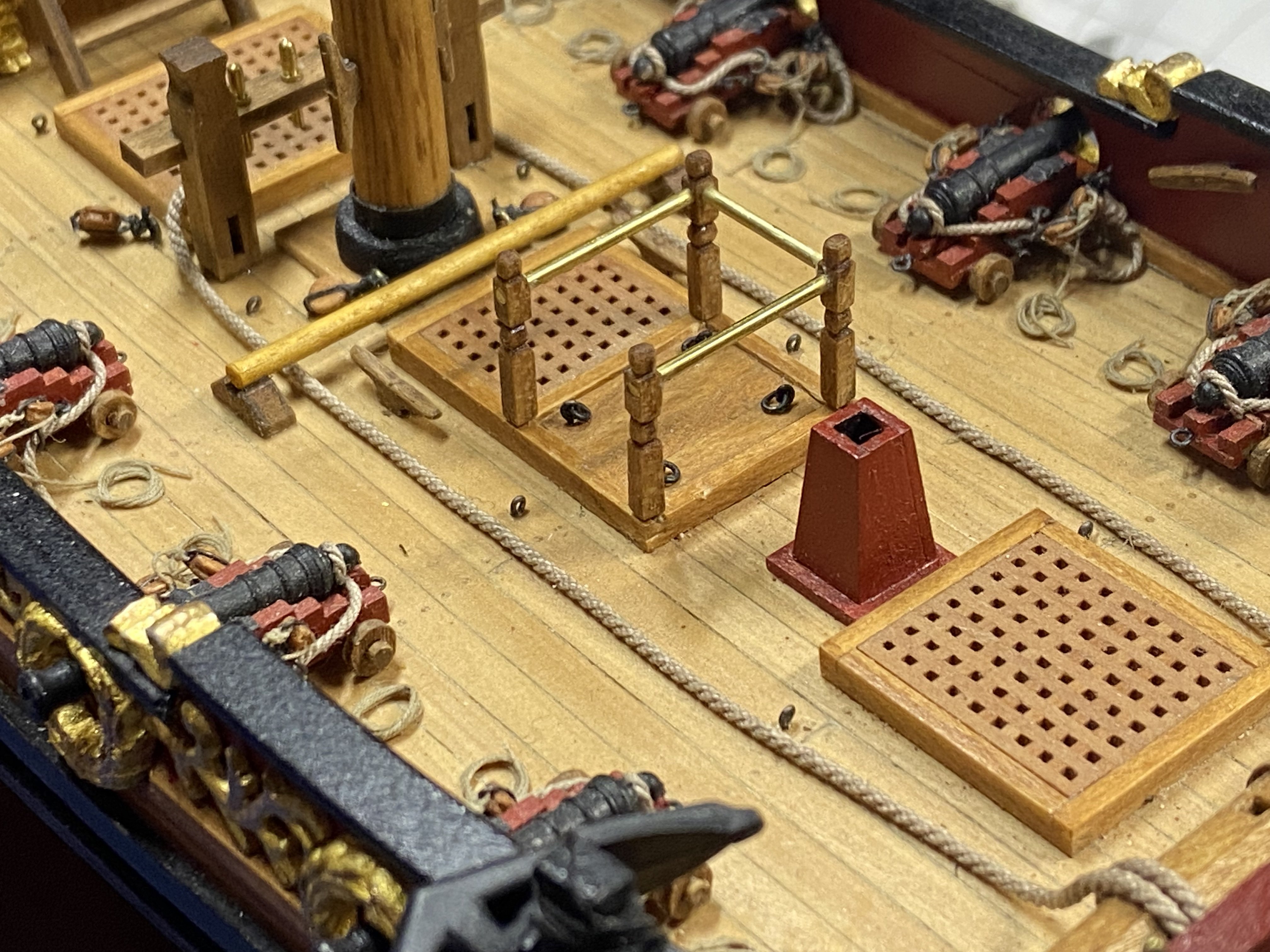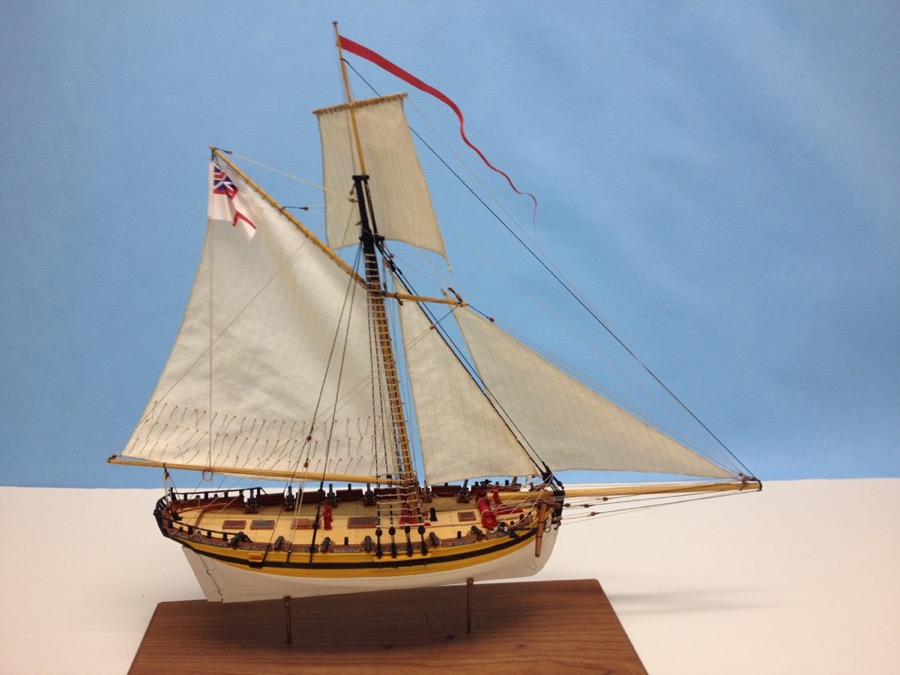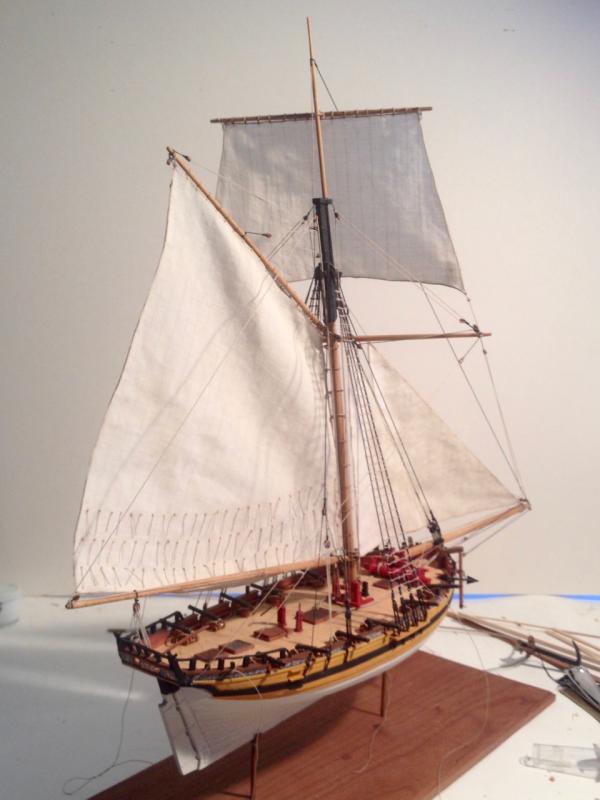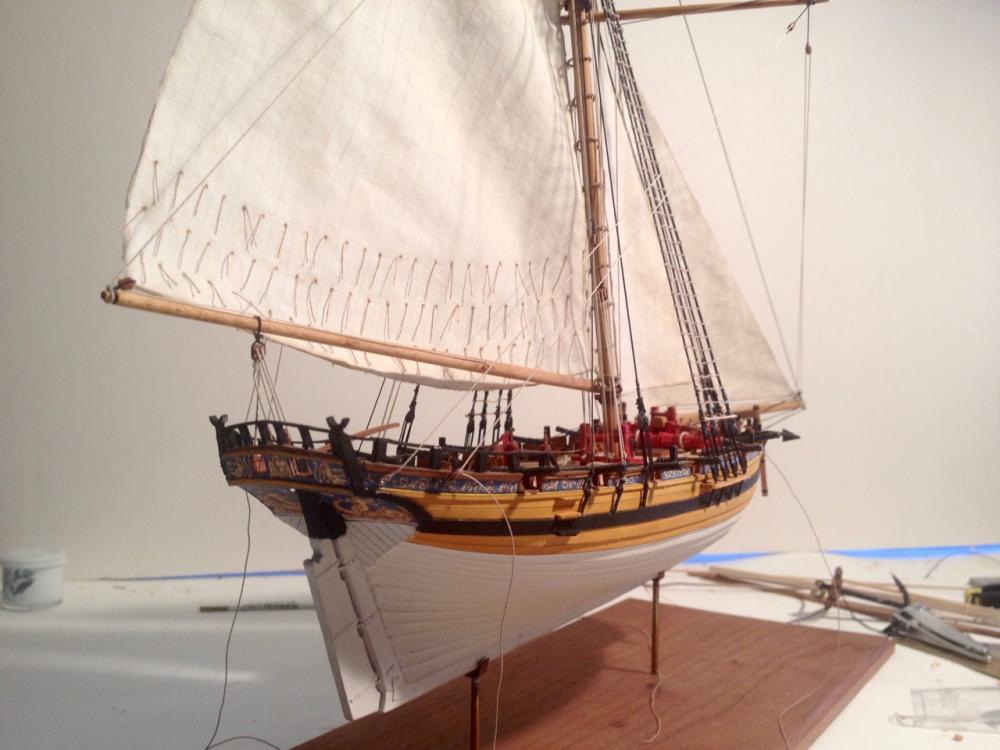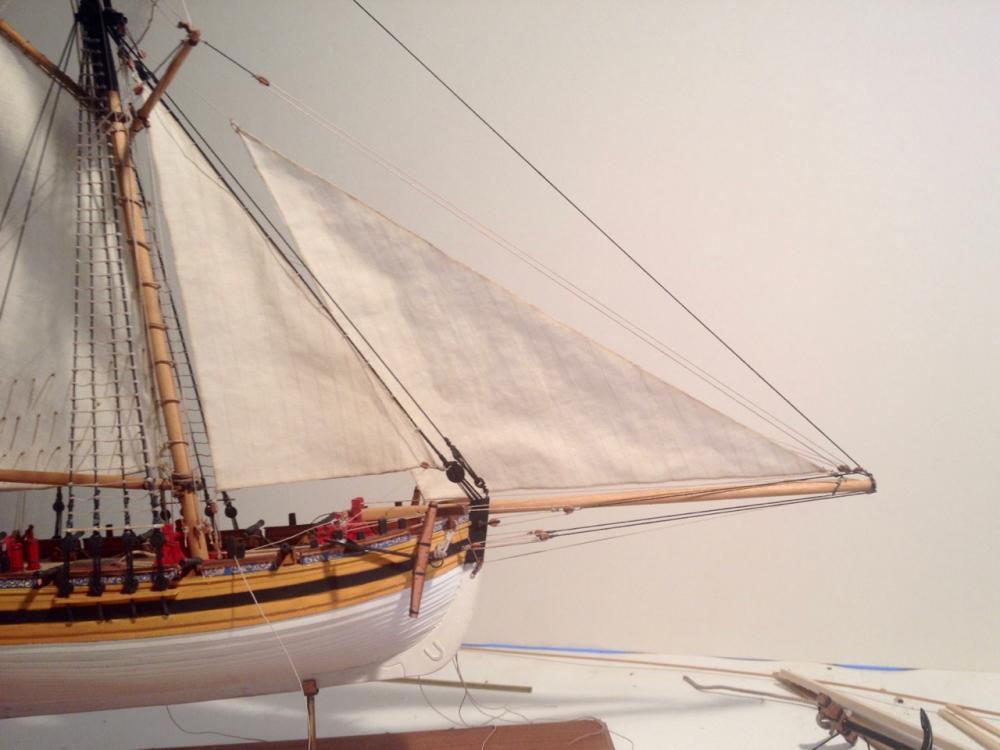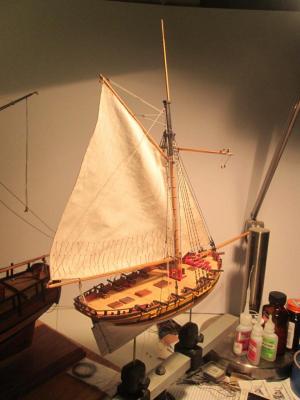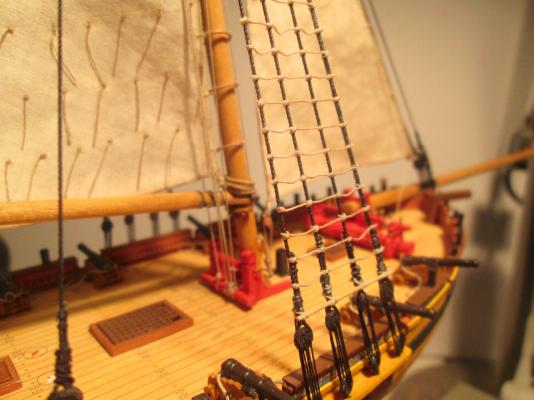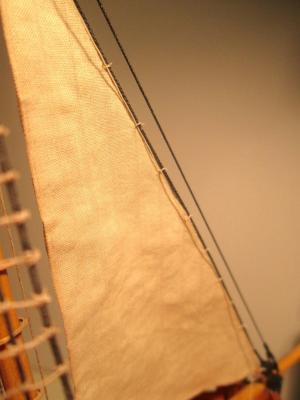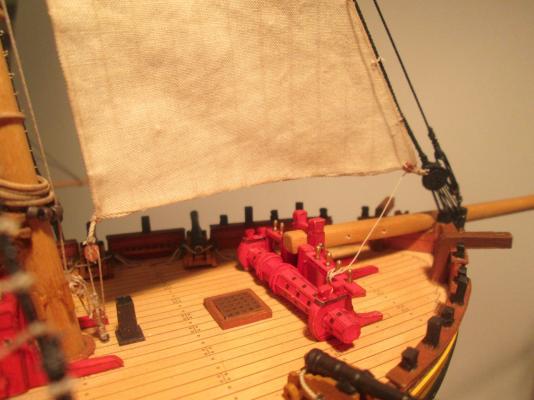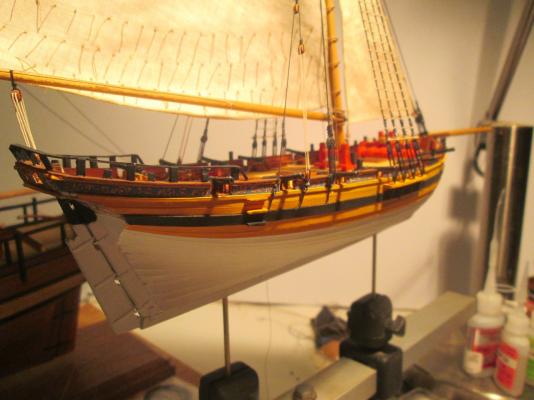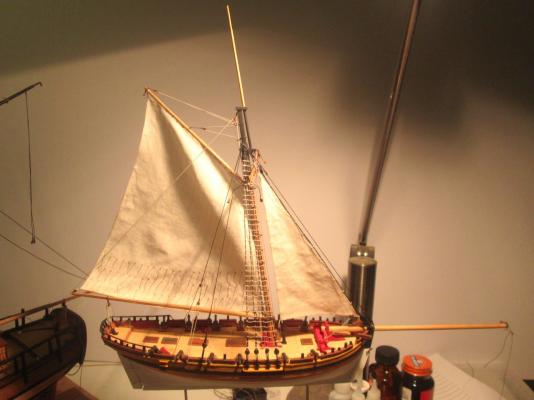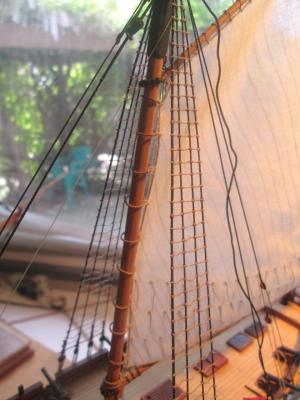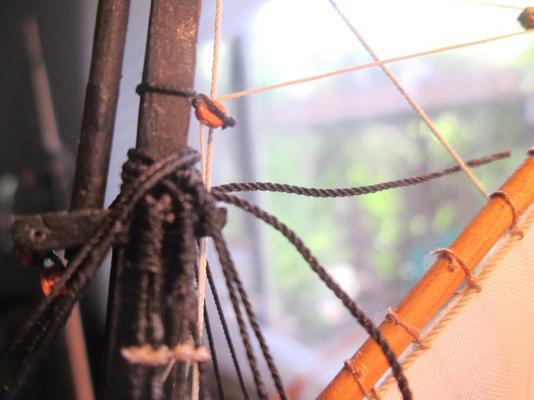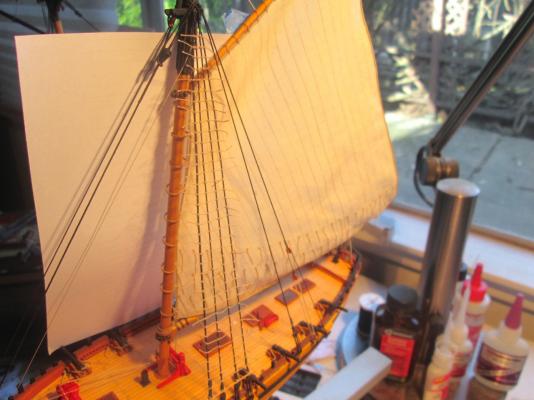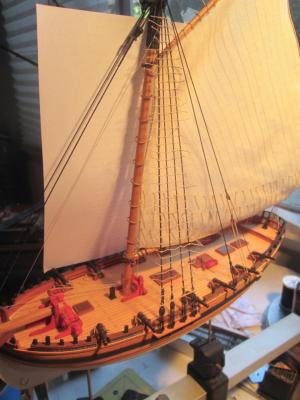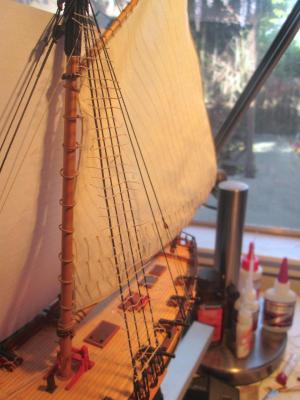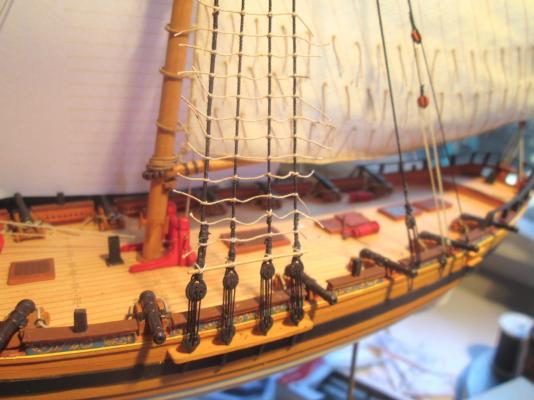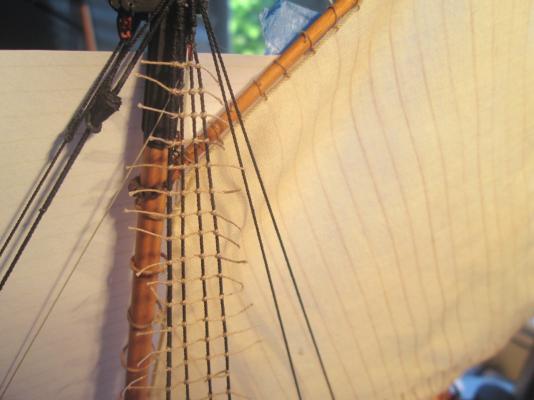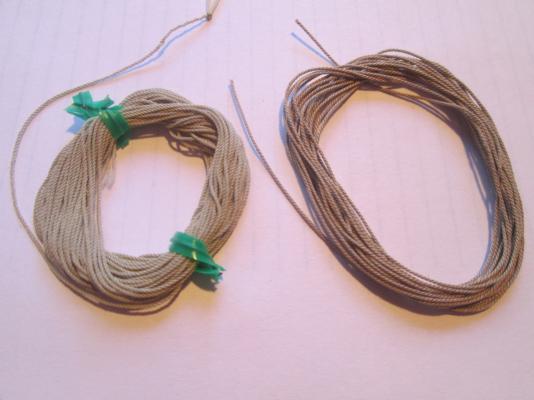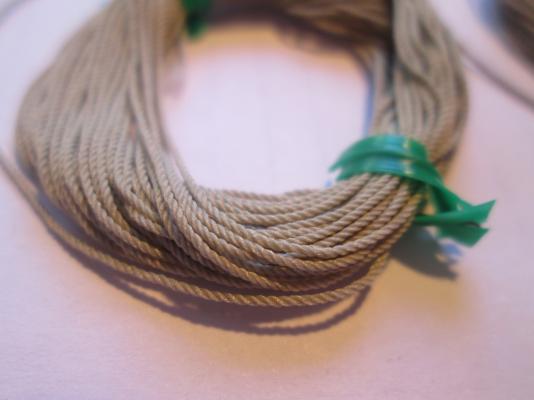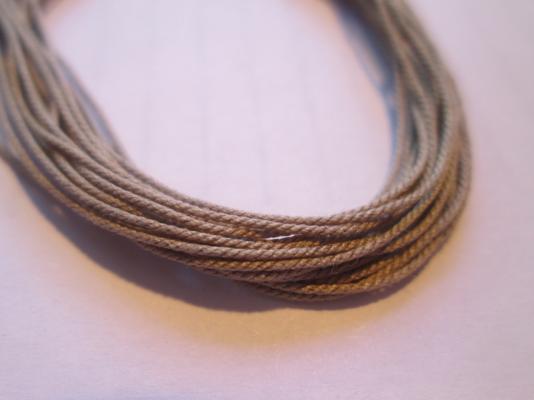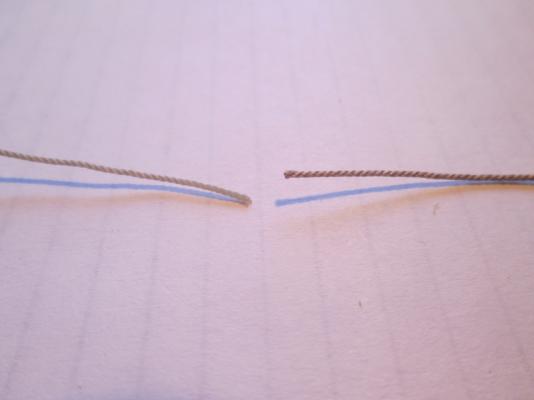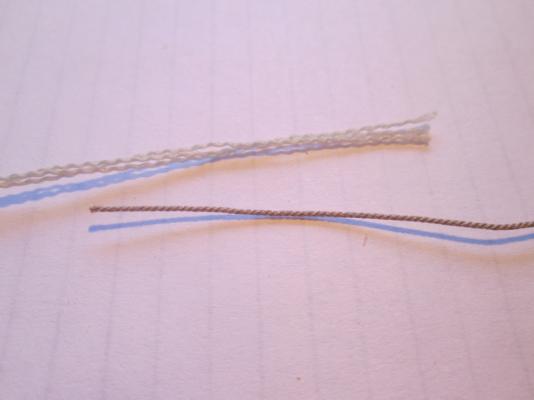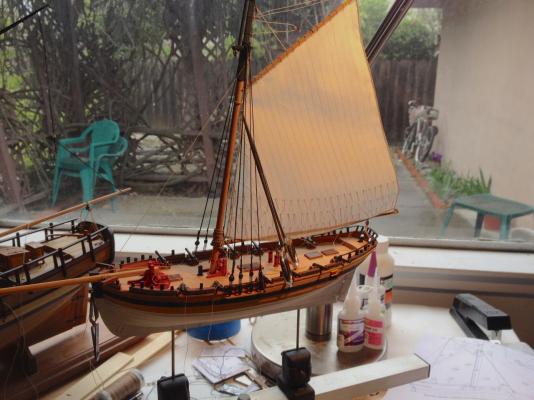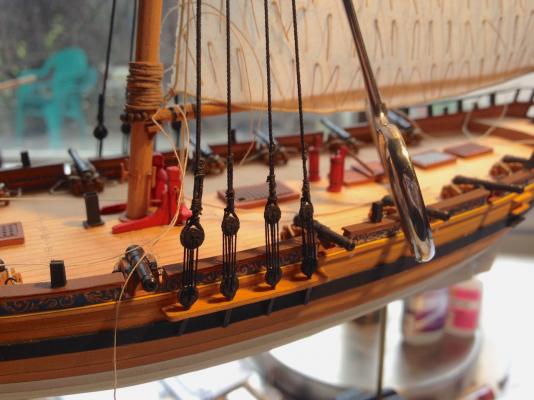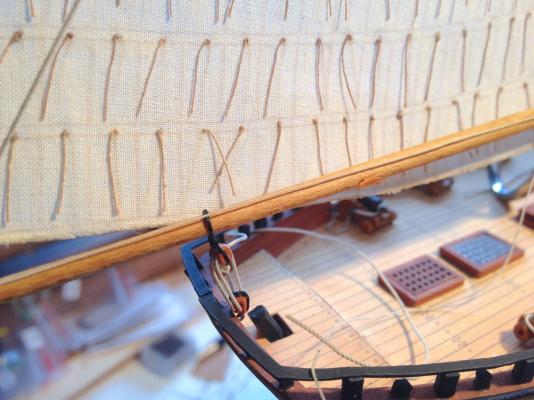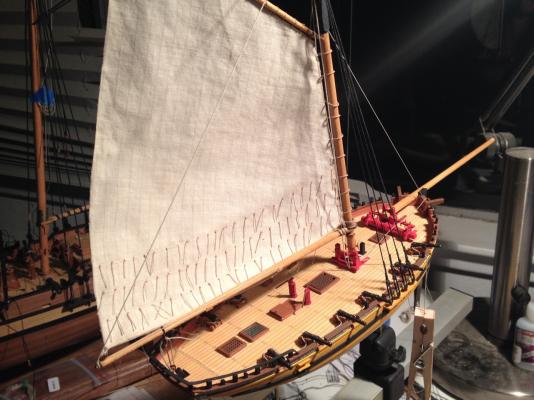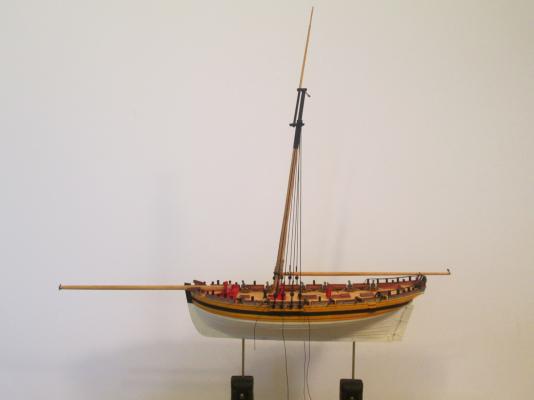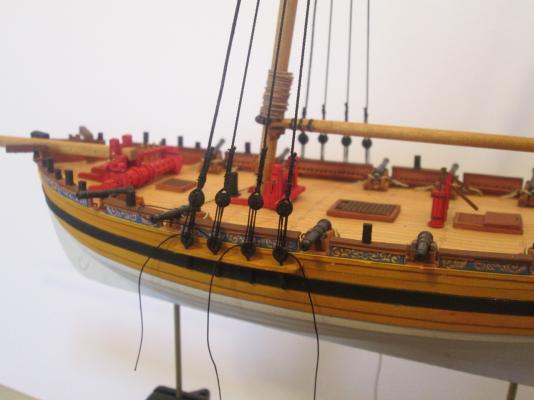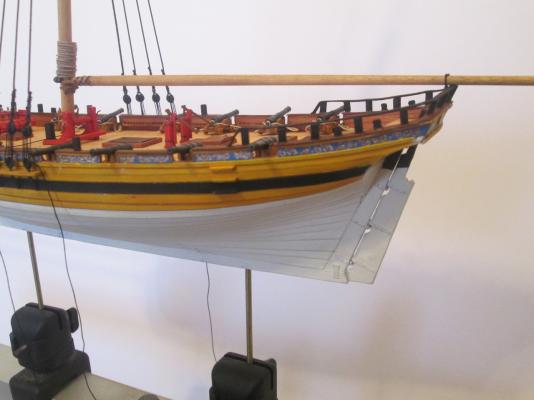-
Posts
1,772 -
Joined
-
Last visited
Content Type
Profiles
Forums
Gallery
Events
Everything posted by catopower
-
Thanks again everyone for the kind words. Druxey, I'm like a stealth ship modeler. Nothing... nothing... nothing... then whammo! But, seriously, HMS Alert is officially complete! I just adding a bunch of rope coils and have the case nearly finished. The case is an acrylic box which will be brass trimmed, and it will set on a cherry base. I'm ship modeler, not a woodworker, so don't anybody expect too much. I hate building cases. But, it's necessary to keep the model save. Plus, if properly done, it "frames" the model nicely, and makes it look more valuable. The model will have a home with a fellow ship modeler who's been admiring it and inspired me to take it to completion – it started as just an experiment on paper model making. However, we've made arrangements for me to take it to the NRG Conference in San Diego this October. Having felt a kind of strange separation anxiety from paper model making now, I've decided to move forward on another one to work on in the background, the 1/8" scale HMS Mercury – not the expensive, larger boxed kit, but the smaller CHEAPER paper model. I purchased the kit from Ages of Sail and picked up a "Super Detail Kit" for it from GPM. The detail kit includes gun carriages, capstan, gratings, ships boats, and some other parts in laser-cut cardboard. Most importantly, it provides laser-scribed scrollwork/figurehead so that's not so 2D, plus some nice laser-cut parts for the stern gallery lights, which are just printed paper in the basic kit. I'll start a build log on it in the near future, but I'm focussing my attention to other projects I need to get done. I will probably get far enough along by October to show it off at the Ages of Sail table at the Conference. I'll post the remainder of the HMS Alert photos in the Gallery. Thanks everyone for following my build! Clare
-
We're VERY close now! I finally finished building up the fashion pieces and boom crutches at the stern. This was the probably the part that took the most creative thinking of the whole model. The paper fashion trim didn't fit due to construction variation in my model – that is, I didn't line up the parts as intended! Also, the drawings weren't very clear as to how the parts fit and just what parts were needed at the rail. This is the reason I'm doing this work after most of the rigging is done. It took me a long time to decide on how to best approach the problem. As it is, it seemed to work out. Luckily at 1/8" scale, the details are too small to really discern any problems. Or rather, if there is a problem, my eyes are worn out enough that I can't see them. Rigging is nearly complete now too. I just added the braces to that topsail spreader yard and just need to secure them once the positioning seems good. Next, I'll need to add braces to the small upper yard. The hardest part of the rigging now is really just how to secure the sheets for the jib. Not that difficult, just requires a little more thought because of how low I have mounted it. Last thing will be to add the flags and their halliards. Should have things wrapped in another week or two! Clare
-

Some criteria for starting a new group project
catopower replied to Chuck's topic in Group Projects on Model Ship World
Carving is great idea and so is sailmaking. But there is one subject that I would absolutely sign up for on a group build, and that is making figures for ship models. I've tried making figures before, I have a couple books that talk about it, but I haven't been very successful at it. Would love to be able to make figures in 1/8" scale, 1/4" scale, and even 1" scale. Clare -
That's excellent news Daniel! You must now have a HUGE pile of work ahead of you. Are the Mini-Mamoli kits going to continue to use pre-carved hulls? Just curious. I expect to find out that you'll be locked away in a ship model kit designing dungeon for many months to come! Best of luck with the new product line. I'll be looking forward to seeing the new re-releases. Clare
-
Hobbie, A lot of the mantua kits come that way. It was a very early way of providing etched brass parts. You're going to want to first cut the parts to the outer blue (thick) edge. Don't cut too close – use a file to finish the edges. For some of the larger parts, in particular the ones that have multiple windows, I think you're going to have to cut them further, like to the inside of of that blue border, but check the fit of the part, to make sure first. You're probably going to want to paint instead of leaving it all as plain brass. The blue is, I believe, a residue coating that protected the metal from the acid bath. You can remove it by using a very find sandpaper. Paint the recessed areas as necessary. If you like the coloring of natural brass for the raised areas, just lightly sand away any paint you got on the raised areas. Otherwise, paint the raised areas carefully. Clare
-
Thanks again all for the nice comments. Sorry, it's taken me so long to come back here. Once I got the model off the workbench and onto the shelf, I got preoccupied by the next piece of business. For one, I just wrote up a piece for the Nautical Research Journal. Hopefully, it will make more people aware of this wonderful kit. In the meantime, I know of two others who will be building the Tosa Wasen kit and I hope to see a build log from one of them soon! mwb?? For the record, I'm tinkering with the construction of a 1/10-scale Japanese traditional boat workshop display. It's really just the framework of the shop with much omitted for visibility. I'm not sure how interesting it will end up. I'm still tinkering with ideas. If you don't know anything about how these boats are/were built, you should visit Douglas Brooks' blog and/or buy his book: http://www.douglasbrooksboatbuilding.com. To get to his blog directly, visit http://blog.douglasbrooksboatbuilding.com. He was just in Japan for a couple month building a rice field boat for a museum up on the Noto peninsula and another boat, from Northern Japan I believe it was, for a museum in down in Kobe. The boat I'm going to piece together for the boat workshop is an Urayasu Bekabune, a small fishing boat used on Tokyo bay. You can find more info about the boat on Brooks' website. The one for the boat workshop display will be only partially built, since the idea is for an "under construction" scene. But, I'll complete another one, since at some point in the project, I'll know how. And, it's a very simple type of boat – much simpler than the Tosa Wasen. Clare
- 51 replies
-
- wasen
- thermal studio
-
(and 1 more)
Tagged with:
-

1/10-scale Japanese Fishing Boat kit from Thermal Studios
catopower replied to catopower's topic in Wood ship model kits
Oh, I DID see that! I don't know what I was thinking. Apparently, I was not. Thanks for the wake-up call wefalck! Clare -

1/10-scale Japanese Fishing Boat kit from Thermal Studios
catopower replied to catopower's topic in Wood ship model kits
Thanks Wefalk, I actually saw the cover in the last issue of the Nautical Research Journal, so I visited that website and ordered a copy. It took me a while to translate from French, but found it an interesting Part I. I'm looking forward to the other parts of the series. One thing that wasn't clear to me was the name of the author. Do you know who wrote it? Clare -

1/10-scale Japanese Fishing Boat kit from Thermal Studios
catopower replied to catopower's topic in Wood ship model kits
Hi Mark, I'm glad to hear that you're getting the kit. I'm only just starting to hear from people who are buying the kit. You're the second person in a week that I've heard from. FYI, the other person tried emailing info@thermal-kobo.jp and waited a week with no reply, so he emailed shop@thermal-kobo.jp and got a reply within 24 hours. Here's his post on Model Space: http://forum.us.model-space.com/default.aspx?g=posts&m=189319post189319 The link you provided didn't work for me, but this did http://thermal2.exblog.jp/i65/ without the 1// at the end. If this is the page you're referring to, that's Douglas Brooks sitting next to Masaki Tanimura, who runs Thermal Studio. Douglas had mentioned seeing the Tosa Wasen model, a few years ago, but didn't remember any details about it. I know he stopped in Kochi City a few years back and stayed overnight with a friend who created the drawings that the kit is based on. I think this photo is from that visit. Looking forward to seeing your build log! Clare -
Thanks Cog. I made a bit more progress this past week, though it doesn't really look like it. I finished rigging the lines dealing with the main sail, and added the staysail, halliard and downhaul, added brace pendants to the topsail yard, and then some. Plenty more to do still. I have a lot of bowsprit rigging to deal with, plus the jib and squaresail to add. Also have a little bit of hull details to add and a few small deck details. But, it's getting there. Clare
-
Hi grsjax, Ages of Sail carries their kits as well as kits they make for other companies like the Nordic Class Boats line. I thought they looked similar in production style and quality to Dusek kits. The Panderma that Thanasis posted a link to (a build) seems pretty popular. The Mariefred (a Nordic Class Boats kit) won some kind of best product award in Germany last year. They do have some unusual subjects, which is really nice. Clare
-
Tony, What a fantastic job you are doing on this build. The only negative comment I can make on this blog is that there is only a LIKE button, when there should be a LOVE button! A masterfully built model. I hadn't looked in on it before, but now I'm going to have to go back to the beginning of your blog and start learning how to build a ship model the right way. Clare
- 269 replies
-
- Caldercraft
- First build
-
(and 3 more)
Tagged with:
-
Thanks for the comment and advice Carl, all. Well, I think I'm able to declare success! Had the quarterly meeting of shipmodelers at our gathering place at the Vallejo Naval and Historical Museum yesterday morning. After nearly 3 hours ship model shop talk about lunch with a fellow shipmodeler afterterwards, I managed to have a marathon session of rattling down the shrouds. All worked out pretty well and I didn't notice the stretching issue as much. So, this morning, I tried spraying the completed work with the fixative. The matte varnish had a bit of sheen, so I used the matte fixative, which dried much faster, so I could use a heavier coat. It didn't really do much to lock the clove hitches in place, so I just brushed on some acrylic matte varnish. I know it works and it's quick to apply. I trimmed off the excess line from the ratlines and the shouds looked okay. But, then... I went ahead and took a thick piece of black rigging line, threaded it under the shrouds and then pulled the line tight. As I did, I could feel it slip tight against the mast head and I could actually see the shrouds tightening up. I know it's cheating, but you will never be able to see this extra piece of line at this scale. And, after all, much of model making is about the art of illusion. Below, you can see the excess line sticking out. So, now, after I secure that piece of line and cut the excess, I can comfortably start rigging the standing rigging on the bowsprit. Clare
-
Hi Carl, You reminded me that I have a couple cans of artist's matte spray from Prisma Color and from Grumbacher. Do you know how those compare with the hair spray? Grumbacher is a Matt Varnish, Prisma Color just calls theirs "Fixative". I'm guessing that "fixative" is just an expensive can of hair spray. Appreciate the advice! Clare
-
Hi Cog, I never really considered it. Do you know what kind of chemical is used in hairspray? I assumed it wore off after a short time. But, now that you mention it, I have hit the hull and deck with a little Testor's Flat Lacquer. Hides those tiny glue specks really well. I was thinking about hitting the rigging with it to help seal the line and to secure the knots. So, maybe that's the same idea as what you're suggesting. Clare
-
Thanks Carl, I appreciate any comment that suggests that I don't have to fix anything! Mark, to answer your earlier question, the Morope is a little shiny in the closeups, as you say. And to answer your question, it's Polyester. Clare
-
Hi Mark, The need for pre-stretching might be the issue here. Too late for the work done so far. But, it hasn't affected the backstays or the forestays, just the shrouds. The other thing that I started to consider is the perhaps there IS a paper model issue here. I'm wondering if anyone with paper sailing ship model experience has noticed some settling of the mast down into the hull, even a miniscule amount. Just in case, in the future, I thing I would put some reinforcing at the mast step. Thinking on it now, I can't imagine the card stock NOT crushing just a little under the strain of the rigging. But, I could just be imaging excuses for my own shortcomings here. I finished the ratlines on one side, but haven't trimmed or glued the knots in place yet. Still thinking about how to procede. I might have to step away from it for a bit and look at it with a fresh perspective. Tomorrow, there's a ship modeler's gathering I organize at the Vallejo Naval and Historical Museum near Mare Island. I'll probably take it there and see what people think. Again, I may rattle down (?) the starboard side shrouds and then see what I can do to tighten it all up together. Clare
-
In my last post, I didn't have any photos to illustrate the differences in the rigging line that I was referring to. So, I took a few shots to post here. Above is a coil of Morope on the left and Syren line on the right. They both have good definition and look very nice. I don't recall the difference in pricing, but I don't remember it being a very great difference. Here is a closeup of the Morope line. And a closeup of the Syren line. The above are roughly equivalent sizes. And, of course, for my model in 1/8" scale, I'm only using very small sizes. So, the larger sizes will look a little different in comparison. What's shown is roughly 0.4 mm diameter line. When the Morope is glued so that it doesn't unravel, it doesn't look too different from the Syren line. Except of course, the Syren line looks like this freshly cut, without any special treatment. While this doesn't usually happen to me since I make sure to glue the line before cutting it, here is the Morope and the Syren line both freshly cut with no special treatment of the line. As you can see, the Morope wildly unwinds. It will continue to do so if it's not tied off or treated with glue. It's not necessarily a problem if it's handled properly. But, it's a shame it's like this as the Morope does have very good visual definition, and is available in left and right hand twists. I haven't run into any serious problems with the stuff as far as I can tell, but it is a concern as I work. Also, the Morope does seem stretchier and doesn't hold it's shape as well as the Syren line. For instance, if I make a coil of line, the Syren line is easier to work with, and holds the shape better. I'm not trying to push one or the other. I'm just pointing out the difference and a possible related issue I'm having with the forward most shrouds, which are served Morope line. Clare
-
Well, just to report that I ran into my first real problem with the Alert. However, it has nothing to do with the fact that this is a paper model. This has to do entirely with the rigging material I chose. I decided that this small model provided a good opportunity to try using a product called MOROPE. This stuff has been around for many years. It's made in Europe and there is a person in the U.S. that handles U.S. sales of the product. The stuff looks really good and is visually stiff competition for Chuck Passaro's rigging line because it is well defined and is available in both Left and Right-Hand Lays (both S and Z laid). The first downside to MOROPE is that it's not really properly turned. If it was, when you cut it, it wouldn't immediately start to unravel. Seems like they don't twist the strands first... or is it yarns or threads? Anyway, when you cut Syren line, nothing bad happens. To keep the MOROPE from unravelling, you need to hit the area you're going to cut with some glue first. Then, it cuts just fine. However, now I'm tying ratlines – yes, lovely ratlines in 1/8" scale, so the rows are only about 5/53" apart. As I'm doing this, I'm finding that the MOROPE shrouds are stretching just a little. It may be a small enough stretch that I can compensate a little. But, this far into the rigging, if I can't work with it, I'm going to have to tear most of it down and re-rig. For the most part, I suppose it wouldn't be TOO terrible to take the rigging down as it's mostly a matter of cutting lanyards, which can be replaced. But I don't look forward to the idea of reworking the shrouds, deadeyes, etc. We'll see. I'm almost half way done with ratlines. There's only one mast – it's really not like I'm having to worry about rigging on a clipper ship. So, I'll get through the ratlines, trim them, and see how it all looks. I'm sure it's something like I hadn't stretched the line properly first. But, the line is stretchy to begin with and it seemed like the springiness would help to keep the shrouds taught. The detail at this scale is so hard to see, that it might be enough to cheat and tie an extra piece of line tight under all the shrouds, forcing them to lift upwards a millimeter, which would probably be enough to do the trick. Nobody would ever be able to see the fix. Anyway, we'll see how it goes. More later. Right now, it's back to clove-hitches... "under, over, through... under, over, through..."
-
Before putting the main stays in place, I needed to get the shrouds and backstays secured. The problem is that they get in the way of dealing with the mainsail. So, I worked on rigging the mainsail first. The sails came as a set from Shipyard. I originally ordered these direct from Shipyard, but it appears that's no longer possible. I think the company may have blocked U.S. IP addresses, so as to support U.S. dealers, namely Ages of Sail, which sells the Shipyard kits. The problem is that Ages of Sail doesn't currently sell the various accessories. For the moment, if you want those, you can order them from http://www.gpm.pl. Next, I'll be rigging the backstays and then the mainstay. When I want to something a bit repetitive, I will get started on the ratlines. But, that shouldn't take too long, given that there is only the one mast with only lower shrouds. Clare
-
Quick update. I started the rigging process and added the lower deadeyes using 24 gauge annealed steel wire. The kit provides faux chainplates to glue over the wire, which I added later. First, I served the shrouds where they wrap around the mast head. I decided to go ahead and serve the forward shroud the full length using the finest thread I could find, short of using fly tying monofilament line, which I've had trouble using in the past. I made the shrouds long and used a method for locating the upper deadeyes show in some of the Shipyard kit instructions, which has you tied the ends of each shroud together with it's corresponding shroud under the hull of the ship. I just used clips. Then, glue the deadeyes to the shrouds all at the same height, making sure the deadeyes are all oriented the same. Once the glue has dried, you then loosen the shrouds, cut off the excess and then finish wrapping deadeye in the shroud end and trying things off. Of course, you have to make sure that you end up with the deadeye oriented correctly as your wrapping the shroud around it and tying things off. This seemed to work okay, though the served shroud doesn't stretch like the other shrouds, so I seemed to have more issues with its alignment to the rest when I reeved the deadeyes. I didn't tie off the shroud lanyards yet, as I thought I might need to take the mast off the model to work on adding the mainsail, square topsail and boom, gaff and yards. But, given that there is a fair amount of room to work with the mast in place on this cutter rig, I may go ahead and tie them off. I'll probably add the backstays and mainstays before I start on the ratlines. Sorry, the photos I've been taking lately look terrible. I have been experimenting with lighting and backdrops and such and having really mixed results with everything I've been trying. I have some ideas yet, which I can try another time. Meanwhile, I've started adding more blocks, eyebolts, etc. I think I want to get the mainsail into place next before I add the remaining stays. Clare
-
Thanks for the supportive comments Cog, Druxey, Telp and Mark. Cog, okay, you're probably right... Watch. My next paper (card) model will probably have open bulwarks! Telp, I doubt I'll ever go down the path of 3D printing, though there are some 3D printed parts that I'm sure I'll use. I already bought a 3D printed ship's wheel for a 1:78-scale HMS Victory model. I won't necessarily use it if I can make one that looks good enough. Overall, I like building the parts myself, even if they're not perfect. Of course, with a paper kit, it's a different game, with its own challenges. Don't know that I'd ever feel up to the task of scratch-building a paper model. For now, I'll stick to kits, or at least to this one kit. But, I have to admit, I picked up another Shipyard kit (HMS Mercury) that I thought I might partially build as a display model showing the hull construction style. I also thought one would make a great dockyard scene with the ship's hull completed and ready for launch – a follow up to a discussion here on flags mounted on a Royal Navy ship at launch. Clare
-
Thank you Nils. Of course, I can't take credit for making the cannons out of card. I decided my skills weren't up to doing that and having something nice looking, so I did purchase swivel guns from Chuck Passaro's Syren Ship Model Company and adapted them for 1/92-scale 6-pounder guns. I had the hardest time with all the timberheads and the taffrail. Next time I build a paper model, I think it will have no railing like on this one! Clare
About us
Modelshipworld - Advancing Ship Modeling through Research
SSL Secured
Your security is important for us so this Website is SSL-Secured
NRG Mailing Address
Nautical Research Guild
237 South Lincoln Street
Westmont IL, 60559-1917
Model Ship World ® and the MSW logo are Registered Trademarks, and belong to the Nautical Research Guild (United States Patent and Trademark Office: No. 6,929,264 & No. 6,929,274, registered Dec. 20, 2022)
Helpful Links
About the NRG
If you enjoy building ship models that are historically accurate as well as beautiful, then The Nautical Research Guild (NRG) is just right for you.
The Guild is a non-profit educational organization whose mission is to “Advance Ship Modeling Through Research”. We provide support to our members in their efforts to raise the quality of their model ships.
The Nautical Research Guild has published our world-renowned quarterly magazine, The Nautical Research Journal, since 1955. The pages of the Journal are full of articles by accomplished ship modelers who show you how they create those exquisite details on their models, and by maritime historians who show you the correct details to build. The Journal is available in both print and digital editions. Go to the NRG web site (www.thenrg.org) to download a complimentary digital copy of the Journal. The NRG also publishes plan sets, books and compilations of back issues of the Journal and the former Ships in Scale and Model Ship Builder magazines.

